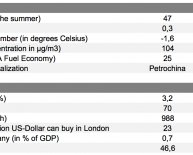
We Can Change Our world
Climate Change is the most serious problem we face in the 21st century. Future generations are depending on us to do whatever we can to turn things around.
 The Union of Concerned Scientists, a group of over two thousand scientists, has concluded that global warming is beyond dispute, and already changing our climate. The last 30 years have seen the warmest surface temperatures in recorded history, and the past several years have been among the warmest on record.
The Union of Concerned Scientists, a group of over two thousand scientists, has concluded that global warming is beyond dispute, and already changing our climate. The last 30 years have seen the warmest surface temperatures in recorded history, and the past several years have been among the warmest on record.
Global warming can be slowed, and stopped, with practical actions that yield a cleaner, healthier atmosphere. The question is: will we act soon enough?
“Many people don’t realize that we are committed right now to a significant amount of global warming and sea level rise…the longer we wait to do something about it, the more change we will have.”
Gerald Meehl, The National Center for Atmospheric Research
Ultimately it is up to each of us, as individuals and families, to take action to slow down and eventually reverse global warming through everyday awareness of our energy use, and attention to ways we can conserve electricity and minimize fossil fuel usage.
What we can do
The goal is to bring global warming under control by curtailing the release of carbon dioxide and other heat-trapping “greenhouse” gases into the atmosphere.
We can contribute to this global cause with personal actions. Our individual efforts are especially significant in countries like the US and Canada, where individuals release over 10, 000 pounds of carbon dioxide per person every year.
We can help immediately by becoming more energy efficient. Reducing our use of oil, gasoline and coal also sets an example for others to follow.
Reduce electricity usage around the home
The largest source of greenhouse gases is electric power generation. The average home actually contributes more to global warming than the average car. This is because much of the energy we use in our homes comes from power plants which burn fossil fuel to power our electric products.
To reduce the amount of electricity used in our homes:
- Switch to energy-efficient lighting
Replace the familiar incandescent light bulbs with compact fluorescent bulbs. For each CFL bulb replacement, you’ll lower your energy bill and keep nearly 700 pounds of carbon dioxide out of the air over the bulb’s lifetime. CFL bulbs last much longer and use only a quarter of the energy consumed by conventional bulbs. LED bulbs are also energy-saving, but have a narrower range of application. Advances in LED bulb technology, however, are leading to more applications for these bulbs in the home. LEDs are more efficient than CFLs and do not have issues surrounding disposal, as do the CFLs. More info. - Improve the efficiency of home appliances
Home appliances vary greatly in terms of energy-efficiency and operating costs. The more energy-efficient an appliance is, the less it costs to run. You can lower your utility bill and help protect the environment. Here’s how. - Buy energy-efficient appliances when shopping for a new appliance
Do this especially when shopping for a major appliance such as a refrigerator, dishwasher, or air-conditioner – select the one with the highest energy efficiency rating. By opting for a refrigerator with the Energy Star label — indicating it uses at least 15 percent less energy than the federal requirement — you can reduce carbon dioxide pollution by nearly a ton in total. More info. - Reduce energy needed for heating
According to the U.S. Department of Energy, heating and cooling systems in the U.S. emit over a half billion tons of carbon dioxide into the atmosphere each year. Much of the energy used for heating our homes is wasted, and yet the prevention is, in many cases, simple and inexpensive. Here’s how. - Reduce energy needed for cooling
Air conditioners alone use up to 1/6th of the electricity in the U.S. and, on hot summer days, consume 43% of the U.S. peak power load. You can reduce much of the need for air conditioning, and enjoy a cost savings benefit, by using ‘passive’ techniques to help cool your home. Here’s how.






















